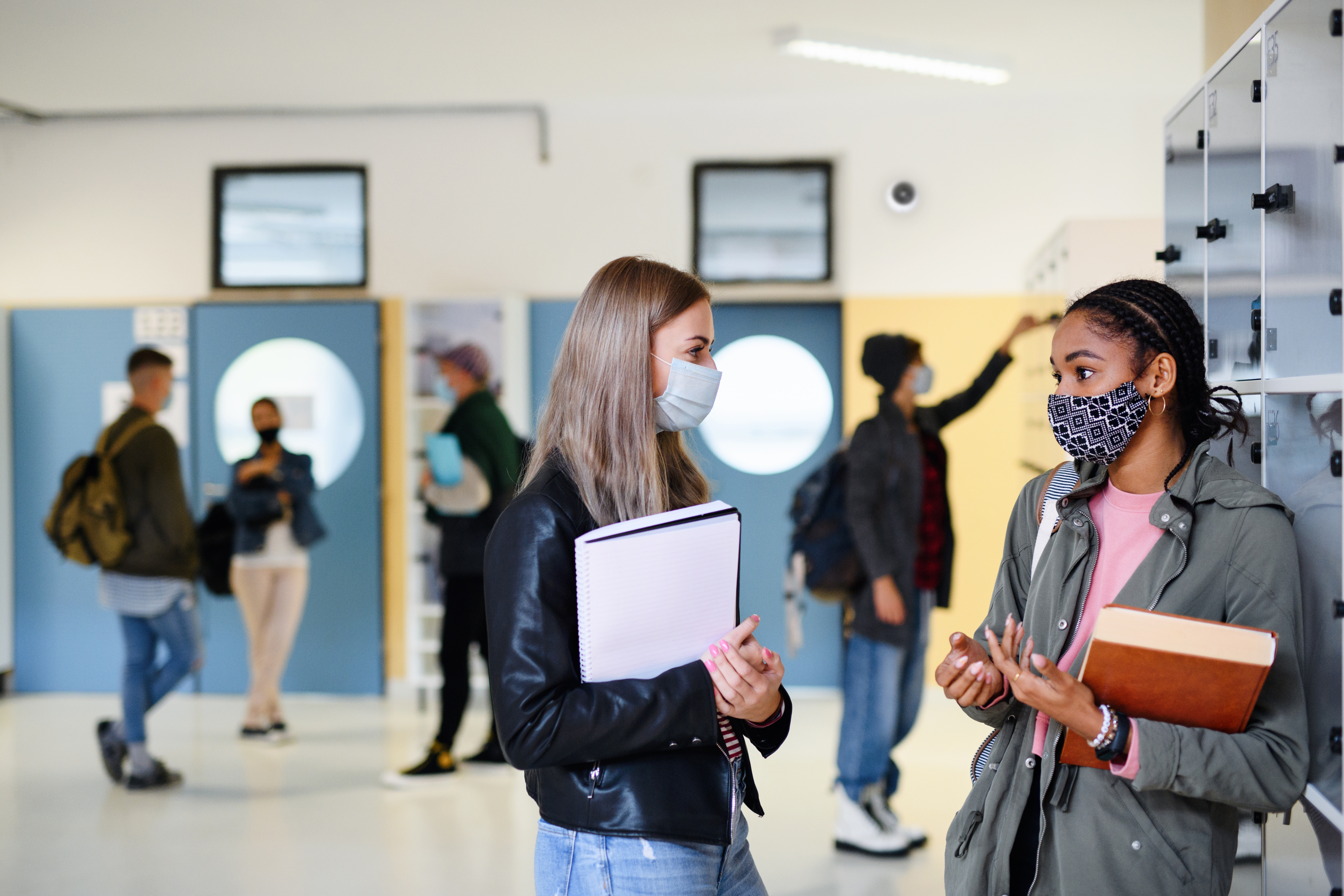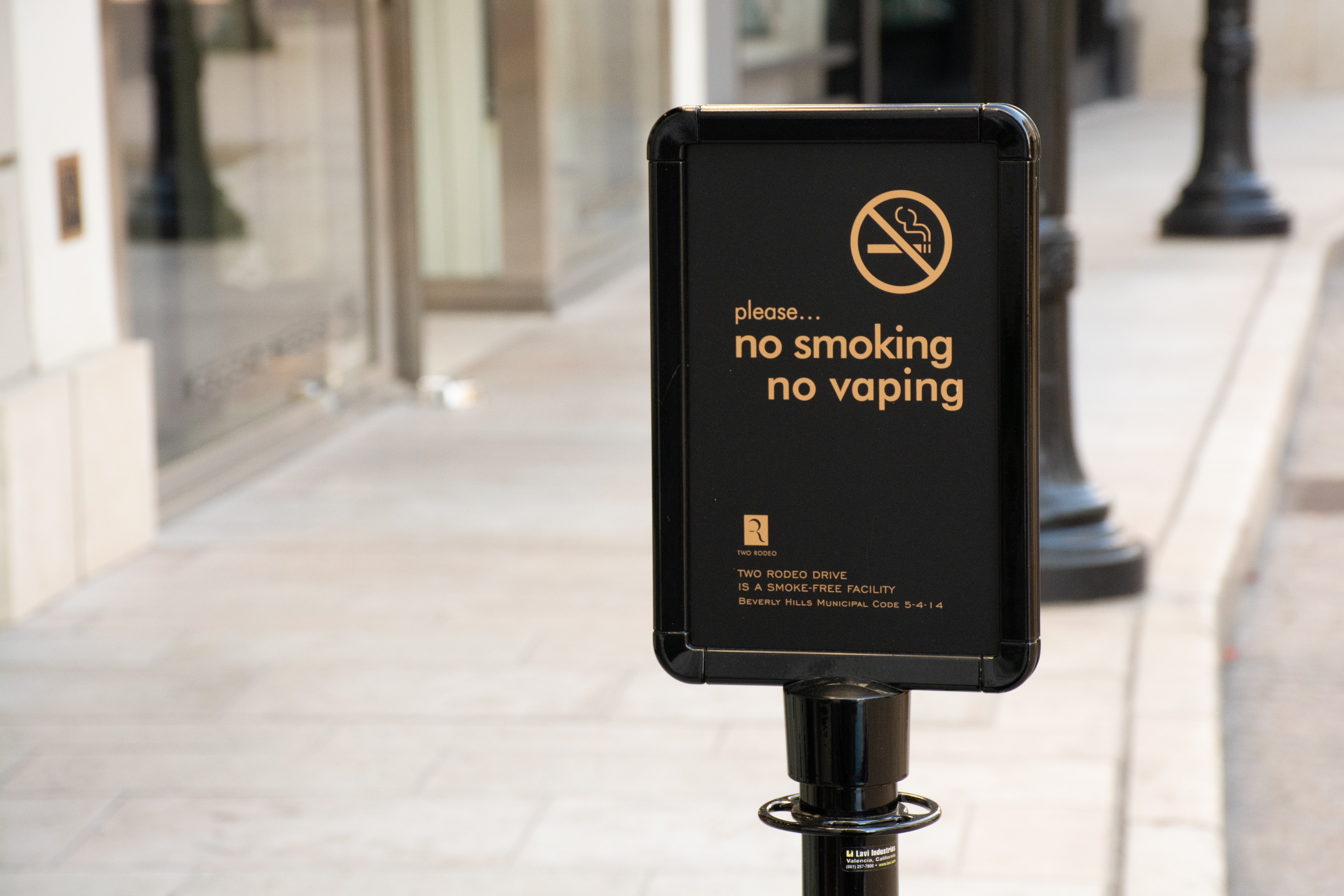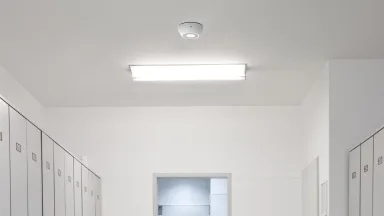Previous generations of students had it tough—to smoke cigarettes, they had to sneak off-campus. Smoking cigarettes at school was possible, but the smell of smoke would give them away.
Today, young students can vape right in the classroom, and their teachers may not even notice. Not only does this influence young people to use e-cigarettes, but it poses a threat to the health and safety of all students.
What makes vaping so attractive to middle and high school students?
Electronic cigarettes (e-cigarettes, for short), are small, hand-held nicotine delivery devices that heat a nicotine liquid into an inhalable vapor. E-cigarettes come in all shapes and sizes, but many are smaller than a USB drive.
Some e-cigarettes look like traditional cigarettes, cigars, or pipes. Others look like everyday items such as pens or USB memory sticks. Some are designed to resemble common household items, like highlighters or even key fobs.
These battery-powered vape pens produce an aerosol “vapor” that can contain nicotine, flavorings, and other chemicals. The vapor looks similar to the smoke from a cigarette, but it doesn’t have the same smell.

Unlike regular tobacco products, which have one distinct taste, e-cigarettes come in hundreds of fun flavors, like cotton candy, mango, or mint. This makes them more attractive to the 800,000 young people who tried them for the first time in 2022 alone.
How are students getting away with vaping in school?
Because vapes don't smell like regular cigarettes, they are easy to hide. Students can take a quick puff between classes, in the bathroom, or even right in their seats.
In some cases, the vapor dissipates too quickly to be noticeable. In other cases, students can blow it into their clothing or hold it in their mouths before exhaling, reducing, or eliminating the vapor altogether.
A few of the most common places students vape include:
School Bathrooms: Bathrooms are private, and multiple students can use them throughout the day, making it easy to sneak a quick vape.
Classrooms: Especially if a student sits in the back of the room, it can be difficult for a teacher to see them vaping.
Hallways: During passing periods, students can easily blend in and vape without being noticed. During class time, they can use e-cigarettes while nobody is around.
Locker Rooms: Like bathrooms, locker rooms are private places where students can vape without being detected.
And since these devices are so small, students can easily put them in their pockets or backpacks.

Increased youth vaping creates distractions in the classroom.
In 2019, the Truth Initiative hosted an online discussion with educators about how vaping impacts their classrooms. One of their primary concerns was how vaping can be a major distraction.
When students use e-cigarettes, they are not paying attention to the lesson. This is a problem for all students in the class, not just those who don’t use tobacco products.
When students share an e-cigarette with their friends, they naturally draw attention to themselves. As students around the class start to look, they focus less of their energy on the teacher and the lesson.
This can have a ripple effect, leading to more students being distracted and less engaged in learning.
E-cigarette use can lead to lower academic performance.
When students vape in school, it’s not just a distraction for other students. It can also lead to lower grades and academic performance.
A 2021 study found that students who began to use e-cigarettes missed assignments, skipped classes, and reported lower GPAs than those who didn’t use tobacco products.
The Truth Initiative's 2019 data confirms this—teachers have personally noticed that e-cigarette use among their students has led to poor academic performance.
"A kid showing signs of (nicotine) addiction has mood swings (that they may or may not have had before), sudden drop in grades or loss or change of friend groups," one teacher said, describing how e-cigarette addiction has impacted her students.
And this impact goes beyond test scores and homework assignments—school events, sports, and other extracurricular activities are also heavily impacted.
Teachers feel their hands are tied when it comes to school vaping policies.
Half of the teachers surveyed by the Truth Initiative felt that they didn’t have enough power to address e-cigarette use in their classrooms effectively.
Reasons for this include:
Difficulty finding students' vapes
Challenges with vape detection
Lack of prioritization from the school
Limited resources to address youth vaping
Lack of parental support and engagement
Some schools added vaping to their current smoking and drinking policies to prevent students from using e-cigarettes, but this isn’t always effective. But since vaping happens in the classroom and other school spaces much more frequently, the same policies don't always translate.

In many cases, teachers bear the responsibility of catching students vaping and enforcing school policies in their own classrooms. Rather than educate their students, middle and high school teachers across the country must intervene to enforce failing school policies.
Student-teacher relationships suffer, and so does schoolwide culture.
Since policies don't effectively tackle the issue of vaping on school property, it often falls on the teachers to deal with it. And since vaping devices are difficult to detect, the trust between teachers and students begins to erode.
This mistrust can lead to a negative school culture, where students feel like they can't rely on their teachers and adults in positions of power.
And this culture can be toxic—not just for the students, but for the teachers, too.

At the student-to-student level, peer pressure and the social norm of vaping make it hard for students to say no. Researchers estimate that around 1 in 17 high school students vapes daily, and there are millions more who have at least tried it once. And without effective policies in place to curtail the vaping epidemic, it isn't just easy for students to get away with—peers can't escape.
As young adults continue to vape, it threatens public health and safety.
As policies allow vape incidents to slip through the cracks and a lack of supplementary support systems makes it difficult to address the issue, more and more young adults are taking up vaping. Let's take a look at how vaping impacts school health and safety:
1. Nicotine use can harm adolescent brain development.
In middle school and high school, students go through critical changes in their developing brains. Nicotine impairs the growth of neurons and directly harms the portions of the brain responsible for learning, memory, and attention.

Brain development continues until around age 25, so the more nicotine exposure young adults have now, the greater the risk for long-term problems.
2. E-cigarettes adversely impacts lung health.
E-cigarettes contain potentially harmful ingredients, including metals like lead, volatile organic compounds, and cancer-causing agents. According to the American Lung Association, the effects of these toxic chemicals have amplified consequences for young adults and their lung health. And this lung damage can have long-term effects (e.g., lung cancer, bronchitis, and serious lung disease), particularly for teens who vape every day.
3. Teen vaping leads to early addiction.
In addition to the health risks associated with the harmful chemicals in vape juice, nicotine is highly addictive. Young adults who vape are at a greater risk of developing a nicotine addiction than those who don't. When users inhale nicotine, it quickly enters the bloodstream and travels to the brain.
This increases levels of the neurotransmitter dopamine, which is associated with feelings of pleasure. The body then begins to crave more nicotine to keep dopamine levels high, leading to nicotine addiction.

39% of high school students who vape used e-cigarettes 20 or more days in the past month, according to the most recent data. If nearly two in every five students are using e-cigarettes that frequently, it's likely that they will carry nicotine dependence into adulthood.
E-cigarette companies have been targeting young adults in their marketing for years. And as youth e-cigarette use grows, the social norm becomes more and more accepted and quitting vaping becomes less probable.
4. Widespread adoption results in younger users.
As more young people use e-cigarettes, the average age of first-time e-cigarette users continues to drop. Middle school students are now trying e-cigarettes at younger and younger ages. The CDC reports that 550,000 middle school students currently use e-cigarettes, which is only increasing.
For young teens, early adoption is the result of a domino effect. All it takes is one student with a brother or sister who vapes for the curiosity to set in. And since it's so addictive, the vaping epidemic can spread like wildfire.
5. Vaping e-cigarettes infringes on other students' health and safety.
When students vape at school, it's not just their own health and safety that's at risk. E-cigarette aerosol can have a secondhand impact on those around them, particularly for students with asthma or other respiratory problems.
Secondhand emissions from e-cigarette aerosol can actually be more harmful among students who don't smoke or vape themselves, since they're not used to inhaling the chemicals.
When teen vaping impacts the students and school personnel around them, it is no longer just an individual issue—it becomes a massive public health and safety concern.

What can schools do to address the vaping epidemic?
Across the country, how to stop vaping in schools is becoming a major conversation. To stand up against the teen vaping epidemic, there are eight things that schools should do:
Create an effective vaping policy: A clear and concise vape-free policy is the first step to addressing the problem. The policy should include disciplinary actions for students who violate the rules, as well as education on the risks of vaping.
Increase monitoring and enforcement: To ensure the policy is being followed, schools need to increase schoolwide monitoring for vape-related incidents. This might include more frequent check-ins during lunch or after school, as well as more random locker and backpack searches. It should also include building security cameras and vape detectors in bathrooms and other common areas.
Educate school staff: When staff members are educated on the risks of vaping and how to identify vape-related incidents, they can play a crucial role in prevention. Each school administrator should be trained on the signs of vaping, so they can take action when necessary.
Engage parents: Parents need to be involved in the conversation about teen vaping, both at home and at school. Schools can host parent workshops or send informational pamphlets to a family member to start the dialogue.
Educate students: Many young adults are unaware of the harmful consequences of vaping nicotine. Students need to be educated on the risks of vaping, as well as the school's policy against it. This education should start early—in middle school—to prevent students from ever starting to vape.
Enforce consequences: If students are caught violating the school's vaping policy, they should be subject to disciplinary action. This might include detention, suspension, or even expulsion, depending on the severity of the case. The consequences should be strict enough to deter students from vaping, but not so severe that they are unreasonable.
Provide support and resources for students: Some young people vape because they struggle with other issues, like anxiety, depression, trouble at home, peer pressure, or a psychological issue. In other cases, they need the help from an addiction specialist. Schools should provide support and resources for these students, so they can get the help they need to stop vaping.
Capture student data: Many schools collect data on student vaping, which can help administrators understand the scope of the problem and develop targeted prevention strategies. This data can be collected through surveys, focus groups, or student interviews. It can also be gathered through environmental monitoring systems placed on school grounds.
Track and Capture Vape Events With Verkada
In the fight against vaping on school grounds, monitoring potential vape events is critical to catching students in the act and preventing nicotine addiction.
The Verkada environmental sensor line uses a proprietary algorithm to capture environmental changes, including TVOC, PM2.5, and motion to identify e-cigarette use. By installing environmental sensors in hallways, bathrooms, and locker rooms, schools can be alerted of potential vape events as they happen in real-time.
The Verkada environmental sensors also collect data on vape events, so schools can track the prevalence of vaping over time. Schools can use this data to adjust prevention strategies and target areas that need more attention.

Verkada's comprehensive security solution puts two and two together for school administrators. Cameras, access control, and video management software all come together to create a cohesive security strategy that can be tailored to each school's unique needs.
With Verkada, schools can finally get ahead of the vaping epidemic and create a safer learning environment for all.
To learn more about vape detection and prevention with environmental monitoring, join an upcoming webinar, request a free trial sensor, or email [email protected] for a live demo.



